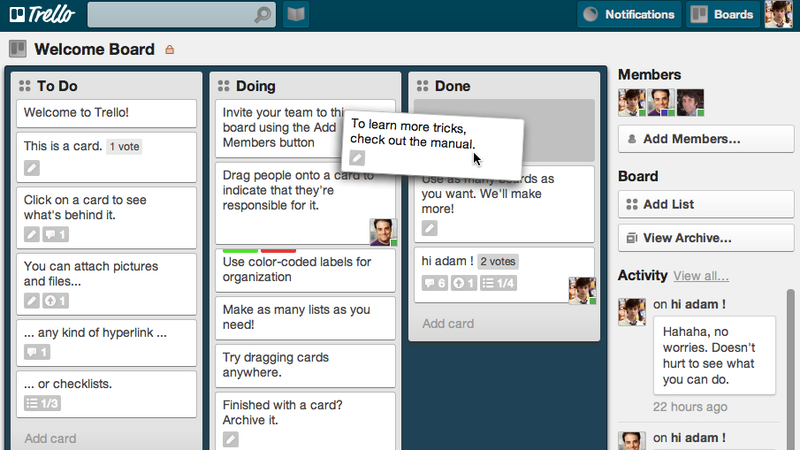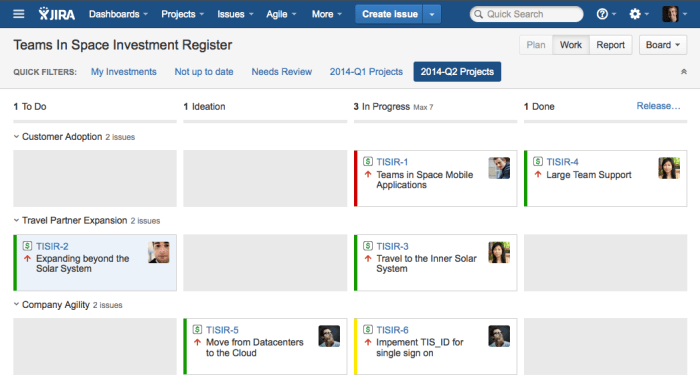
The Completed column will contain cards that represent projects that have been completed and released. The Near term and the Future column will contain cards that represent initiatives further away on the horizon, that’ll be validated and broken down into more detailed specs later. Since the development process of coding, testing and releasing is just a small part of the overall product management flow, most of what’s happening in your Trello board will be represented by cards in your Current column. Each of these cards might have a number of linked ideas or specs, representing features or experiments that will be created to try to solve the problem. Think of these roadmap cards as problems to be solved. Instead, your roadmap cards in ProdPad will actually contain links to the Trello cards encapsulated in them! These are at a higher level than the Trello cards in your development board that represent features or stories. Each of the cards on your roadmap represent high-level initiatives or projects.


In each of these columns, you’ll have roadmap cards. We like to call these Current, Near term, and Future. Your roadmap will shift in granularity and scope as it goes further into the future, represented as the time horizons. Trello is great for tracking progress at the feature level, but you’ll need a roadmap to tell the bigger story of your product strategy. Instead, use these two approaches to figure out what goes next: the roadmap and the ideas backlog. You’re never going to sort through all of this in one narrow list of cards. There are things that’ll get you revenue, or user growth, or a more stable platform to build on. There are things that your customers are asking for all the time. There are things that will move certain metrics that will mean you hit your company objectives. There are things in your backlog that might be important to your product vision. Not by making blind decisions based on their own opinion, but by asking the right questions and weighing up all options.Īnd there’s a lot of things that will influence what goes next. You’ll need to size up your backlog in a variety of ways in order to make informed decisions on what gets built next.Īfter all, if we were, to sum up the role of the Product Manager, it’s to be the person who decides what to prioritize. Keeping these functions separate means you’ll be better at both.įollow this rule of thumb: Every card in Trello should be an actionable and approved task, ready for a developer to pick up and move to the Doing pile.Īs for all of the things that are still being spec’d, validated and approved? ProdPad helps product managers identify where to take your product next, Trello helps teams execute the plan. “What should we work on next to move this metric?”.It gives you the tools to answer questions about the future of your business: ProdPad picks up where Trello leaves off: managing the complex and tangled interests of customers and stakeholders while keeping you on track to meet your product vision. How do you track customer problems? How do you manage the influx of input and opinions coming in from across your organization? How do you handle business and revenue objectives that influence your priorities? If you want to make sure you’re building the right things, you’ll need a better space to manage your product backlog. We’ve seen some… creative… ways to keep it from getting unwieldy, from tags to extra columns, but the reality is that your product backlog is more than an ordered list of cards. It’ll also muddy up your developers’ ability to clearly see what they need to work on next. Left unattended, it’ll grow and grow, and make it harder to make informed decisions on your priorities. The visual board makes it easy to see where things are getting stuck.īut what about that ever-growing list of things piling up in your “To Do” column? As long as you’re watching Work-In-Progress (the number of cards in each column at any time), work will progress pretty smoothly. It should give your developers the autonomy they crave, but it shouldn’t overwhelm them with an untidy backlog of half-formed ideas and not-yet-approved specs.Īlmost every development board on Trello has some variation of the Doing, Testing, and Done columns. They each solve completely different problems: ProdPad helps you figure out your product strategy – what to build and why, while Trello takes over to help your engineering team build it well – the execution.Ī good development process focuses on execution. It’s not a matter of one versus the other. Good question, and one we can answer because we use ProdPad and Trello together to build our own products!

If you’re using Trello already, you might be asking “Trello vs ProdPad? What’s the difference? Why do I need them both?”


 0 kommentar(er)
0 kommentar(er)
